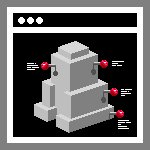Advanced CAD Software
 |
Market Trends
- Competition for market share among CAD software developers will become more intense. Microsoft has recently purchased Visio Technology. Visio produces IntelliCAD. IntelliCAD is a direct copy of AutoCAD. Thus, with its purchase of Visio, Microsoft (the world’s biggest software company) finds itself in direct competition with Autodesk (the world leader in CAD software). Microsoft hopes to merge Visio’s advanced drawing tools into its Office suite of products. AutoCAD has a proprietary file format. Visio’s ability to read and write AutoCAD files threatens AutoCAD continued dominance in the market. Microsoft has proved to be a fierce competitor. Traditionally, Microsoft has expanded its business by targeting a segment of the software industry where they don’t currently compete. They then try to buy the company that sells the most popular software package in that segment of the market. If this fails, they buy a competing company and revamp its product so it can better compete with the market leader. What generally follows is a fierce price / market share battle for dominance in that market segment. Because of its marketing savvy and financial resources, Microsoft seldom looses such battles. If the same pattern holds true, Autodesk is in for some stiff competition.
- Note the emergence of low priced AutoCAD clones (i.e. IntelliCAD). With the advent of low price clones, Autodesk begins to loose control of the .DWG file format. As use of the .DWG file format becomes the de facto industry standard the use of .DXF file format will decrease.
- In an effort to gain market share, popular CAD packages will continue to leapfrog each other’s features. The intensified competition will tend to shorten software development and release cycles.
- Expect to see basic, striped down, 2-D CAD packages come down in price and capture significant share of the CAD market.
- Intense competition will result in further industry consolidation. Many CAD software companies will merge or disappear.
|
 |
Interoperability & Standardized File Formats
- For the foreseeable future, AutoCAD’s .DWG file format will remain the de facto standard within the AEC industry.
- Note the proliferation of industry organizations aimed at making CAD files less proprietary and more interoperable (most noticeably through the STEP standard). As a result, we can expect the STEP standard to become more popular.
- Note the continued refinement of the AEC industry CAD standards by DoD’s TRI-Services, the CADD Council, CSI and others. As the standards take hold, more and more standards compliant building product data will be made available to the profession.
|
 |
Compound Documents
- Note the increased popularity of compound CAD documents (i.e. different kinds of documents that are electronically linked or embedded into one another). CAD files are fast becoming amalgams of drawings, spreadsheets, text files and databases. Expect this trend to continue and accelerate.
- Note the increased popularity of “smart” drawings (i.e. drawings electronically linked to databases).
- Note the continuing trend to incorporate advanced database and query tools into popular CAD packages (e.g. AutoCAD, MicroStation, clones etc.).
|
 |
Marketing Strategy
- The widespread availability of high performance PC’s fosters the development of “bloated” or feature rich CAD software.
- The old model of “add-on” software modules gives way to integrated packages (i.e. extra features are built directly into CAD software packages like Architectural Desktop and Triforma), thus blurring the distinction between CAD, GIS and CAFM software. The only notable exception to this trend is in the field of engineering analysis. This segment of the market continues to develop highly specialized add-on modules that clip on to popular CAD packages.
|
 |
Smarter Clients
- As time goes on, we can expect that our clients will become more experienced with CAD systems. They will become more demanding as to deliverables. We will have to match our services with their expectations and deliverable requirements. More of our clients can be expected to have their own CAD systems and staff. Standards that we will have to meet.
- Clients will soon come to expect that the CAD drawings we deliver would remain useful over a building’s entire lifespan.
|
 |
CAD Object Technology
- Note the widespread use of Object Oriented Programming to create CAD software (i.e. object technology becomes more popular with CAD software developers).
- The AEC object model matures and gains wider industry acceptance. The AEC object model is enhanced so it is able to recognize construction processes as objects. This allows drawings to be more easily linked to project schedulers and cost estimating software (i.e. Microsoft Project and Primavera talks to AutoCAD).
- Merging of graphic and textual data becomes easier. Interoperability improves and competing software packages learn to share data more easily.
- Note the continued maturation of object oriented CAD software. Drawings evolve into models and models evolve into smart models.
|
(Previous Page)(Next Page)